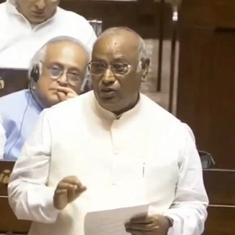The new 19-minute orchestral composition by AR Rahman, The Flying Lotus, is not to be confused with the electronic music producer of the same name. The name, perhaps, hints at the phenomenon that the Bharatiya Janata Party has been in India since it came to power at the Centre in 2014: this deduction is based on Rahman claiming to have based an entire piece on Prime Minister Narendra Modi’s decision to demonetise Rs 500 and Rs 1,000 notes on the night of November 8.
Demonetisation, while initially welcomed by some quarters (although economists expressed their reservations), soon turned out to be a taxing move for Indians. ATM outlets remained closed or non-functional, new notes were in short supply, small businesses were in ruins, and militant insurgency showed no signs of stopping as the government had claimed would happen in the wake of demonetisation.
In an earlier interview, Rahman said that The Flying Lotus is not a judgement on the Modi government’s move. “I wanted to do something on what was going on in India during demonetisation and what will happen in the future,” he had said. “It’s open to interpretation.”
In a country where people are quick to stamp their feet and pass venomous criticism on any work of art that lampoons or comments on the government, it is wise of Rahman to express his thoughts about India’s contemporary political climate through music – specifically, a wordless, instrumental, orchestral piece, which is, as the composer said, open to interpretation.
Any listener, whether casual or a seasoned Western classical music aficionado, can listen to Rahman’s work and enjoy it (or not) but none will be able to demand that a section of the music be censored, or say the composer lacks an understanding of economics.
Or perhaps, there is no ulterior motive to impute from The Flying Lotus. The 19-minute composition ebbs and rises, has highs and lows, is optimistic and sprightly, and later becomes the sound of impending doom. The album has nine tracks (The Flying Lotus is the final one). Tracks one to eight are The Flying Lotus divided into several sections, with the longest one being the four minutes and 25 seconds long – Demonetisation 2016. Ricardo Averbach has conducted the piece while the world renowned Seattle Symphony has performed it.
World of emotions
The album begins with Tiranga, which adds a quaint note. There is a quiet hope in the air. There may be struggle (the violin piques) but it shall be alright (it mellows down). The track feels bittersweet as it progresses and hints at a tension that is explored in the next three sections, before the pent-up emotion finds release in Demonetisation 2016.
Right after Tiranga comes the short and soft Masoom. It is followed by the loud and abrasive Pukaar that sounds like a call to arms. The string-based vivacissimo composition is halted several times by the choir that even ululates at one point. If Pukaar is sinister, Bechain, the last track before Demonetisation 2016, is titled aptly – the word means restless. It begins with distraught strings and an indeterminate flute section, before giving way to a wholesome sound, signalling anticipation.
Demonetisation 2016 begins with a spring in its step. The string and wind sections, and later a heavy brass section, followed by an all-female choir signal the arrival of a king. Suddenly, the piece is interspersed with vocal samples from speeches by Narendra Modi and Arnab Goswami, among others. As the vocal outtakes pile upon one another (Modi’s “Duniya agey badh rahi hai” or the world has moved on, and “Tees December tak mujhe mauka dijiye bhaiyon” – give me time until December 30, friends. Goswami’s is another favourite from the time – “Digital economy will take this country forward.”) percussion enters and the composition becomes more and more agitated until the last 15 seconds abruptly turn into a quasi-Darth Vader theme, as if it were the soundtrack for a menacing alien spaceship landing on Earth.

Light sweeps over the debris, as it were, with the next track titled Subah or morning. A rapt string section and a choir hold Subah together, which in turn seems to behold the aftermath of a monumental event. The next track, Manuhaar, is a celebratory piece high on percussion and trumpets. Manuhaar means one’s way of appeasing someone that is upset with sweet words. One could of course, choose to read meaning into the fact that this track comes right after Demonetisation 2016 and Subah.
Between Rahman’s prolific soundtrack work for Indian films and the occasional Hollywood score, The Flying Lotus is bound to get lost and not receive much fanfare. The ones who keep going back to Rahman’s Bombay (1995) theme or his work on the Lord of the Rings theatre adaptation will find much to chew into in The Flying Lotus. Despite its lack of commercial value, Rahman’s imagination and his vision to express his thoughts on what is going on around him through the only means that he is capable of is indeed laudable.The final track (before the The Flying Lotus) is Mustakbil, meaning future. It is the shortest track on an album and it ends on a resounding high. If this is Rahman’s vision of India right now, he may have his occasional doubts, but at least, he ends it on an optimistic note.











